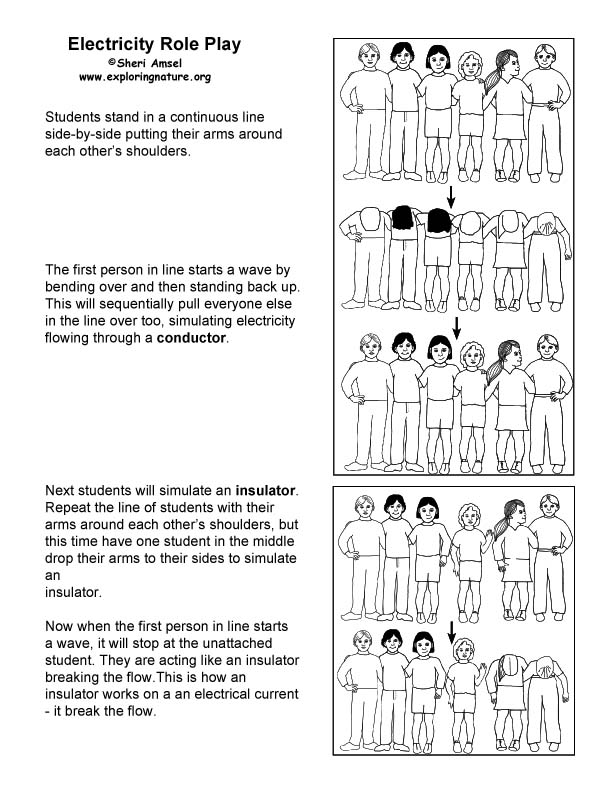

Objective: Demonstrate the behavior of an electrical current when it comes in contact with a conductor versus when it comes in contact with an insulator. For an electrical circuit
to work, it must be continuously conducted from the power
source to the device its powering. If the circuit is broken or
blocked by an insulator, the power cannot get through.
Procedures:
1. Have the students stand in a continuous line side-by-side.
Students will by putting their arms around each other’s shoulders.
2. The first person in line starts a wave by bending over and then standing back up. This will sequentially pull everyone else in the line over too, simulating electricity flowing through a conductor.
4. Next students will simulate an insulator. Repeat the line of students with their arms around each other’s shoulders, but this time have one student in the middle drop their arms to their sides. They should still be next to the other students, but not linked to them. Again, the first person in the line bends over at the waist and stands up. What happens?
4. Discuss with the students what happened this time – how the bending wave stopped at the unattached student. This simulates the effect of an insulator (the unattached student), which is a material that does not allow electricity to easily flow through the it.
5. Point out that a good conductor is a poor insulator and a poor conductor is a good insulator. Brainstorm two lists with the students – one of objects that they think would be good conductors and those that would be good insulators. Ask them how they would find out which was which.
6. After completing your lesson on electricity and circuits, revisit this hypothesis with the students to see if their experiments with insulators and conductors confirmed or refuted their predictions.
When you research information you must cite the reference. Citing for websites is different from citing from books, magazines and periodicals. The style of citing shown here is from the MLA Style Citations (Modern Language Association).
When citing a WEBSITE the general format is as follows.
Author Last Name, First Name(s). "Title: Subtitle of Part of Web Page, if appropriate." Title: Subtitle: Section of Page if appropriate. Sponsoring/Publishing Agency, If Given. Additional significant descriptive information. Date of Electronic Publication or other Date, such as Last Updated. Day Month Year of access < URL >.
Amsel, Sheri. "Electricity Role Play" Exploring Nature Educational Resource ©2005-2024. December 13, 2024
< http://www.exploringnature.org/db/view/Electricity-Role-Play >
